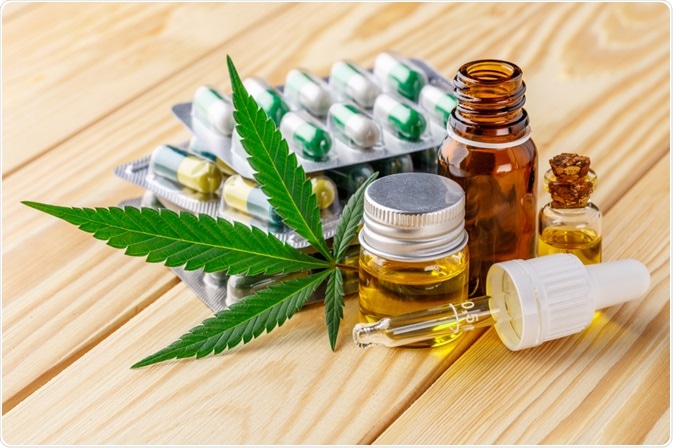Cannabis, specifically its product cannabidiol, is being presented as a therapeutic alternative for epilepsy, pain management, anti-emesis, and many others. As this often involves immunocompromised or pediatric patients, dispensary cannabinoid products must be vigorously tested for microbes and toxic byproducts.

Image Credit: Bukhta Yurii/Shutterstock.com
The advent of faster sequencing methods has resulted in the genomic analysis of a variety of Cannabis species. This has also highlighted the presence of potentially pathogenic microbes. As countries proceed to decriminalize cannabis, sufficient safety regulations must be implemented to protect vulnerable patients. The myriad microbes that have been detected warrant a holistic approach to testing.
The process of drying, storing, and distributing cannabis presents numerous opportunities for microbial contamination. Many jurisdictions recommend heating or pasteurization. Many fungal species are resistant to this process and should be done with caution. Irradiation or ozonation is also not recommended to mitigate microbial contamination.
Water activity is an indirect marker often used to monitor microbial contamination. It is recommended this is maintained at 0.60 ± 0.05. Many US states and Canada have different requirements for microbial detection, these do not always allow for the myriad of potential microbes.
Fungal contamination
Metagenomic analysis of Cannabis species highlighted the presence of fungal contamination. Species of the Penicillium and Aspergillus have been observed. Both produce aflatoxins; these are potent carcinogens. They bind to guanine moieties, generating DNA adducts, damaging the liver. Of particular concern are the four pathogenic species: A. niger, A. flavus, A. fumigatus, and A. terreus.
All four cause immune lung disorders as well as potentially fatal fungal infections in immunocompromised patients. The death of one immunocompromised patient has already been linked to cannabis-associated aspergillosis. Aspergillus contamination continues to be detected in cannabis samples. Fusarium species produce mycotoxins such as fumonisin. Ochratoxin A is another mycotoxin of concern. It can cause nephrotoxicity and is a suspected carcinogen.
Penicillium citrium and Penicillium paxillin are also species of concern. They generate compounds citrinin and paxilline, respectively. These compounds interfere with ion channels and can have serious implications for epilepsy. As patients with epilepsy are often treated with cannabis, detection of these mycotoxins must be accurate.
Bacterial contamination
Bacterial contamination is a lesser concern with cannabis. Patients who use cannabis are often immunocompromised and thus susceptible to opportunistic pathogens. E. coli, Salmonella, and Clostridium are some of the human pathogens observed to be associated with cannabis.
Clostridium is concerning due to its ability to generate botulinum spores. There is no standard protocol for its detection. Listeria poses a concern as many food products are treated with cannabis.
Detection of microbial species
A major issue with microbial contamination is only 1% of microbes are culturable and many toxins interfere with the culturing process. Many commercially available cultures have failed to capture the abundance of species present in Cannabis species.
Another issue is the differentiation between live and dead microbes. Many protocols recommend an additional lysis step to eliminate them to prevent false positives on qPCR results. qPCR is often not specific enough to allow for species-specific detection. For the detection of microbes such as E. coli, Salmonella, Listeria, and indicator species such as Enterobacteriaceae/coliforms and yeast/molds, culturing is acceptable. This is a cheap, accessible process but requires 24-48 hours. Many commercial culturing kits are available.
Aspergillus detection is challenging as it is difficult to discern pathogenic species from nonpathogenic ones. qPCR can generate false positives due to cross-reactivity with non-specified species. Primer synthesis is critical to ensure the accurate detection of pathogenic species. They also tend to clump in culturing: appropriate downstream DNA extraction is often necessary.
Kits are commercially available but must be rigorously evaluated. Next-generation 16S and Internal Transcribed Spacer (ITS) rRNA sequencing is a specialized detection for fungal contamination. This is useful for the detection of pathogenic species compared to non-pathogenic ones. State-approved ELISAs do not detect citrinin or paxilline. Detection of mycotoxins often warrants liquid chromatography coupled with mass spectrometry (such as MALDI-TOF). Once again, this does not differentiate between live and dead organisms.
A holistic approach is critical to effectively monitor and detect the myriad species that can contaminate cannabis. Prevention and detection are both critical to mitigating infection. The detection requirements borrowed from the food industry are not sufficient to cover the microbial variety detected in cannabis. ITS sequencing and mass spectrometry is the most effective means of detecting species and toxins, but these are often expensive.
SMEs are being established which provide microbial detection as well as commercially available kits. Inhouse testing of cannabis needs to be reflective of the contamination that has been detected in the relevant species. Jurisdictions have a responsibility to ensure that the requirements are being met regarding dispensary quality cannabis products.
Sources:
- McKernan, K. et al. (2015) ‘Cannabis microbiome sequencing reveals several mycotoxic fungi native to dispensary grade Cannabis flowers.’, F1000Research, 4, p. 1422. doi: 10.12688/f1000research.7507.2.
- McKernan, K. et al. (2016) ‘Metagenomic analysis of medicinal Cannabis samples; pathogenic bacteria, toxigenic fungi, and beneficial microbes grow in culture-based yeast and mold tests’, F1000Research, 5, p. 2471. doi: 10.12688/f1000research.9662.1.
- Montoya, Z. et al. (2020) ‘Cannabis Contaminants Limit Pharmacological Use of Cannabidiol’, Frontiers in pharmacology, 11, p. 571832. doi: 10.3389/fphar.2020.571832.
- Sarma, N. D. et al. (2020) ‘Cannabis Inflorescence for Medical Purposes: USP Considerations for Quality Attributes’, Journal of Natural Products, 83(4), pp. 1334–1351. doi: 10.1021/acs.jnatprod.9b01200.
Further Reading